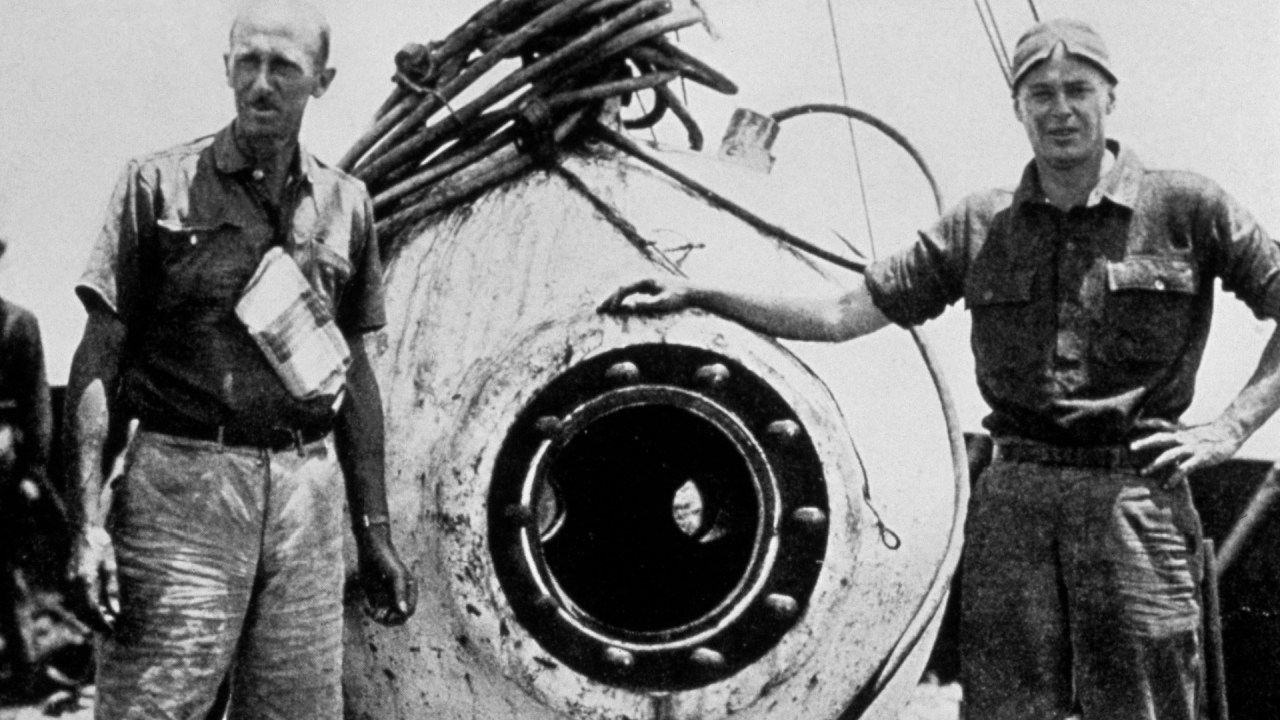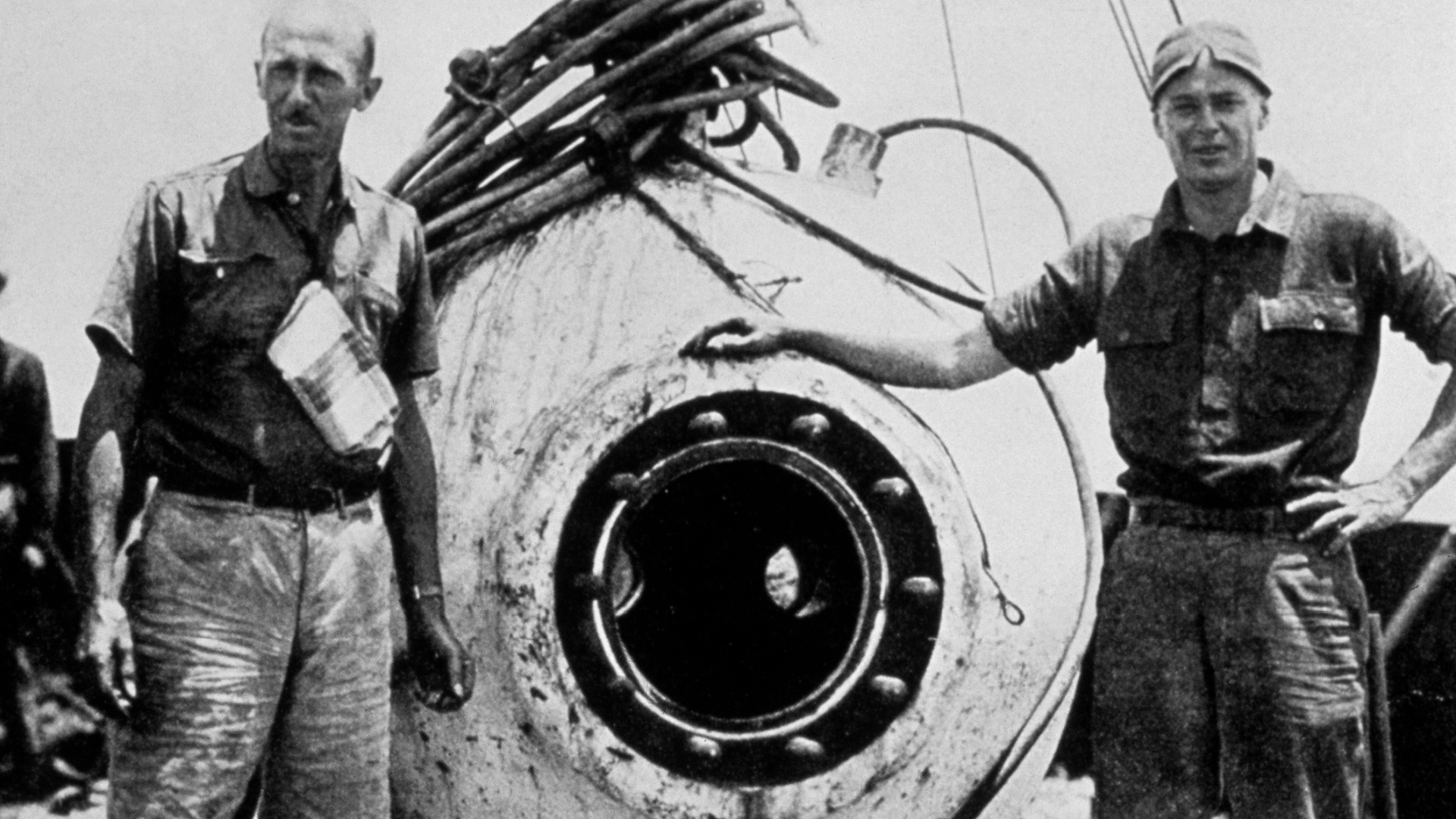Sometime in the early 1940s, when he was living in exile in LA, Thomas Mann picked up a copy of the National Geographic. Leafing through it, he found an article whose strapline was a Jules Verne novel in summary: ‘Half a Mile Down: Strange Creatures, Beautiful and Grotesque as Figments of Fancy, Reveal Themselves at Windows of the Bathysphere.’ Next to dark, exotic images of what appeared to be alien life from the abyssal depths of the sea was an account of how the author, a scientist named William Beebe, had become the 20th century’s first aquanaut in exploits so sensational that live radio broadcasts were made of his dives, as though he were taking a walk on the moon.
Beebe’s descriptions of a brave new world teeming with bizarre life prompted Mann to introduce him into Doktor Faustus (1947), in which the main character, an avant-garde composer named Adrian Leverkuhn, claims to accompany a fictionalised Beebe on his dives. There, ‘in the soundless, frantic foreignness’, Leverkuhn sees ‘the unlooked-at, the not-to-be and not expecting-to-be-looked at… the monstrously extra-human…in den Ozean der Welten’.
Something else lurks in the darkness, 20ft long. ‘Was it a fish at all? How did it move?’
Mann’s appropriation of the story is an analogy for the way art can deal with extremes but also be suborned by them – in his case, the fate of his homeland in the apocalypse of war. There is no mention of this in Brad Fox’s wondrous new The Bathysphere Book, but such is the poetic and often mythical reach of its writing that the episode could easily have found a place there. Its short, sharp chapters are more like separate essays. They deal with Beebe’s adventures and relationships, but entangle with his dreamlike, out-of-body experiences. Thus Beebe’s descent becomes a Blakean heaven or hell, as the giant eyeball of the bathysphere hangs in the abyss. The scientist might discover Isaac Newton down there, sitting on the sea bed, futilely employing his science to work out what it all meant. As Fox dives into Beebe’s biography, the book itself becomes the bathysphere.
Beebe had been fascinated with the sea since he was a student and had seen whales spouting and playing off the coast of New England. ‘I cannot express the peculiar sense of weirdness and freedom which it gave me,’ he wrote, ‘to see these tremendous primeval monsters absolutely masterless, rioting in this vast expanse.’ Working with Otis Barton, an engineer, former actor and deep-sea diver, Beebe designed a machine to realise his dreams.
On 11 June 1930, off the Bermudan island of Nonsuch – part of the same archipelago on which the English sailing ship, the Sea Venturer, was wrecked in 1609, providing Shakespeare with the backstory for his last great play The Tempest – Beebe and Barton descended in their steel ball with quartz portholes. They discovered something rich and strange – not a drowned duke whose eyes and bones had turned into pearls and coral, but pulsating, bioluminescent organisms that lit up the darkness of our human ignorance of their existence.
Fox creates his luminous prose out of these scenes. He shows the miracle of Beebe’s experience in that eerie light; without it, none of that life would have been visible in ‘the darkest place in the world’. Beebe relays descriptions of what he saw via a telephone line to the surface 2,000 feet above. There his lover and fellow scientist Gloria Hollister is listening, taking accurate notes from Beebe’s narration, not knowing if she will ever see him again.
Fox describes this descent, and all that spins out from it, in shards, backwards and forwards in time and space, interspersed with Beebe’s observations in a kind of blank verse:
All the sea plumes have disappeared,
it looks absolutely dead
like the surface of the moon.
Sloping down to a sandy place in the distance…
Looks like death…
something wriggling like mad.
The tension of the line between the lovers, between life and death, is only heightened by the fact that some scientists could not accept what Beebe said he saw. They believed he was high on too much oxygen, or starved of it and hallucinating. Fox nicely contrasts Beebe’s rarefied aesthetic notes with his companion Barton’s sweaty, farty and generally distracting presence as the two necessarily skinny men curl up in the cramped space like overgrown foetuses.
Many of the creatures Beebe saw have never been seen again since, such as a pair of black 6ft-long fishes with dangling lanterns of red and blue lights and teeth like primeval beasts. Then something else lurks in the darkness, 20ft long. ‘Was it a fish at all? How did it move?’ Fox frames it in a memorable phrase as being ‘like the living mirror of a blank mind’.
Other things Beebe sees more clearly he can hardly believe. Great conglomerations of siphonomores, which may be the largest organisms on the planet, but which appear as diaphanous, shape-shifting colonies of multiple creatures. Crucially, he cannot touch or smell or hear these things; his amphibious curiosity is forever at one remove. I know that feeling, having been in the ocean with great whales, in the water with them, close enough to touch, yet still separated by an entire world.
It is telling that it was in these same waters, off Prospero’s isle of strange noises, that the first recordings of the songs of humpback whales would be made in the 1960s. The scientists who taped them were listening for Soviet submarines. What they heard instead were the siren voices of those Edenic New England whales who had first drawn Beebe into the deep. He could not have known that the advances in marine science to which he was contributing would lead to the despoilation of that same watery Arcadia. As deep-sea mining is set to ravage the last wilderness of our blue planet, a scientist working in the National Oceanography Centre in Southampton told me recently that when she was guiding a remote-operated vehicle in an abyssal trench – a venture which provides her research project with new species almost daily – she watched on her monitor as, on that virgin sea bed, an empty Coke can rolled by.







Comments